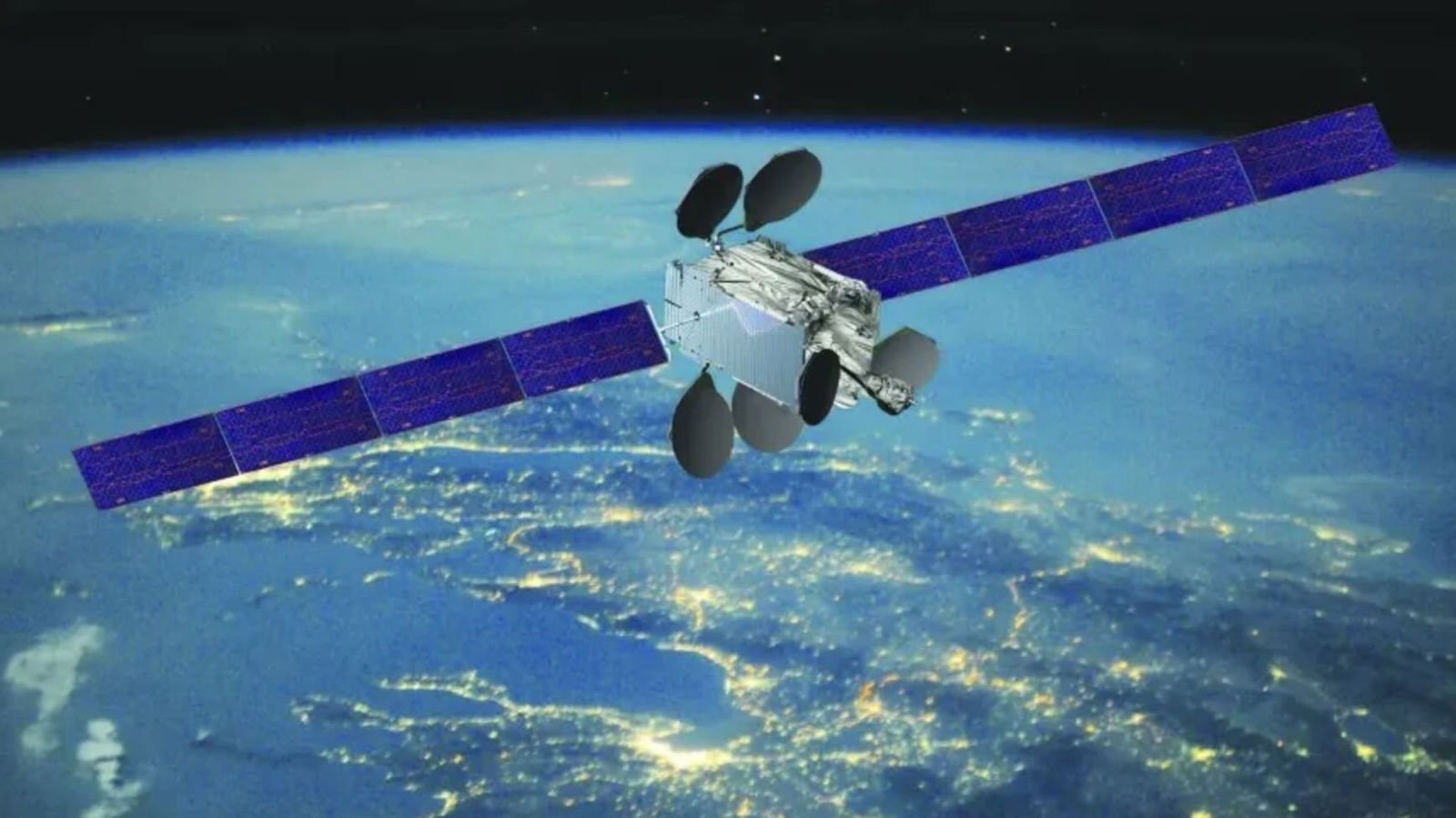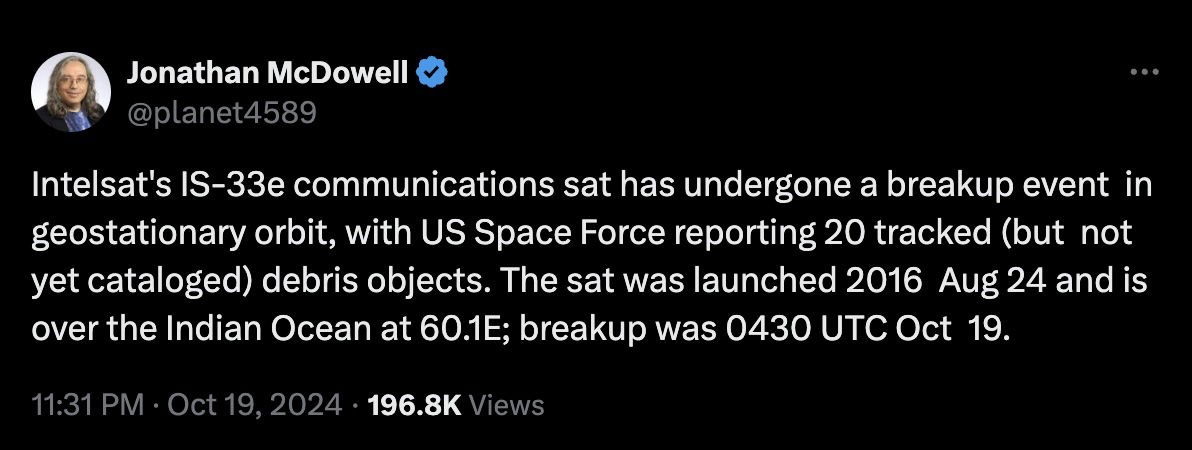

Welcome to this week’s installment of The Intelligence Brief… on Monday, the explosion of a satellite was confirmed following an “anomaly” that reportedly took the spacecraft offline. In our analysis, we’ll be taking a look at 1) what is known about the circumstances involving the satellite’s destruction, 2) what U.S. Space Force officials and other agencies have said about the debris left behind by the spacecraft, and 3) why the unexplained incident has Boeing back in the crosshairs.
Quote of the Week
“U.S. Space Forces-Space (S4S) has confirmed the breakup of Intelsat 33E (#41748, 2016-053B) in GEO on October 19, 2024, at approximately 0430 UTC.”
– U.S. Space Force statement
Latest News: In recent news from The Debrief, Department of Energy scientists report they have captured imagery of a perplexing object that evades easy description. Elsewhere, astronomers scanning TRAPPIST-1 for alien signals have conducted the most extensive single-target search for extraterrestrial intelligence to date. You’ll find links to all our recent stories at the end of this week’s newsletter.
Podcasts: In podcasts this week, on The Micah Hanks Program I take my listeners down the rabbit hole as we examine recent statements by U.S. officials involving fake UFO programs, forged documents, and deceptive counterintelligence measures. Meanwhile, on the latest installment of The Debrief Weekly Report, Kenna and Stephanie discuss the secret powers mice may have and other scientific mysteries. You can find all our past episodes on The Debrief’s Podcasts Page.
Video News: On the latest episode of Rebelliously Curious, Chrissy Newton is joined by Daniel Otis, a Canadian journalist who discusses his recent investigations into the shoot-down of an unidentified object in Canadian airspace last February. Be sure to check out other great content from The Debrief on our official YouTube Channel.
With housekeeping out of the way, it’s time to focus on the events revealed this week involving the unexplained destruction of the Boeing-built Intelsat 33e satellite.
An “Anomaly” Destroys Intelsat 33e
The destruction of a communication satellite earlier this week has officials at the United States Space Force on the watch for debris, following its unexplained explosion just days ago.
Last weekend, the Boeing-built Intelsat 33e satellite was reportedly destroyed following an “anomaly” that prompted unsuccessful efforts to repair the malfunctioning satellite.


The U.S. Space Force confirmed that the satellite, which provided communications services to several countries in Europe, Asia, and Africa, had exploded according to a statement at spacetrack.org, which presents space situational awareness information issued by the U.S. Department of Defense.
The statement added that the Space Force “has observed no immediate threats and is continuing to conduct routine conjunction assessments to support the safety and sustainability of the space domain.”
Unexplained Outage Leads to Explosion
Intelsat initially confirmed in a press release that its satellite was experiencing an outage due to an anomaly on October 19. The company said it was “working closely with Boeing, the satellite manufacturer, to address the situation.” However, it was stated at that time that it seemed “unlikely that the satellite will be recoverable.”
Following the satellite’s destruction, power and communications were reportedly interrupted for many customers across several continents.
On Monday, Intelsat said whatever took the satellite offline remained unclear, but the company was coordinating with Boeing and unspecified government agencies to determine what caused the anomaly. Additionally, the company announced that a Failure Review board would analyze the situation.
U.S. Space Force and Others Tracking Debris
Following its destruction, the U.S. Space Force said it was tracking close to 20 pieces of debris believed to be associated with the satellite as part of what it called routine assessments to ensure overall safety. Presently, there are no threats believed to be associated with the satellite debris, the Space Force said.
Despite the figure provided by Space Force officials earlier this week, the Russian space agency Roscosmos claimed it had identified four times as many pieces of suspected debris from the satellite following the explosion.
“Roscosmos has recorded more than 80 fragments of the destroyed Intelsat-33e satellite,” a statement issued by the space agency read. “According to the OKP ASPO, a significant increase in the number of space objects in the orbital plane of the destroyed telecommunications satellite Intelsat-33e has been recorded.”


Although Roscosmos officials provided no additional details on what may have led to the anomaly that destroyed the satellite, the Russian space agency said that “Analysis of the trajectories of the fragments shows that the destruction of the satellite was instantaneous and high-energy,” characterizing the debris field as “a potential threat to all operating spacecraft, including the Roscosmos group in the geostationary region of outer space.”
Boeing in the Crosshairs Again
Naturally, the destruction of Intelsat 33e had many looking to Boeing, its manufacturer, a company that has remained controversial for several months.
Following a series of issues reported during flights involving Boeing aircraft, probes by federal investigators, and whistleblower allegations, an issue with the company’s Starliner spacecraft earlier this year left two astronauts stranded aboard the International Space Station (ISS).
Ultimately, the Starline spacecraft returned to Earth with no issues, although its intended astronaut crew will likely remain aboard the ISS until early 2025.
The fallout from the company’s ongoing issues reportedly resulted in a loss of more than $6 billion during the third quarter, which experts say will likely cause Boeing to shed as much as 10% of its workforce amid ongoing strikes by large numbers of its employees.
Presently, there are few details on what caused the anomaly that destroyed Intelsat 33e, although the company maintains it “has been in active dialogue with affected customers and partners” as it works to assess the situation and help allocate alternative resources for those affected following the incident.
“Migration and service restoration plans are well underway across the Intelsat fleet and third-party satellites,” the company said on Monday.
That concludes this week’s installment of The Intelligence Brief. You can read past editions of our newsletter at our website, or if you found this installment online, don’t forget to subscribe and get future email editions from us here. Also, if you have a tip or other information you’d like to send along directly to me, you can email me at micah [@] thedebrief [dot] org, or Tweet at me @MicahHanks.


Here are the top stories we’re covering right now…
- Beetlejuice, Betelgeuse, Betelbuddy? Astronomers Find Something Unexpected Orbiting Infamous “Doomed Star”
A team of astronomers says they’ve found something unexpected orbiting Betelgeuse and they have nicknamed it Betelbuddy.
- Explosive Solar Weather Reaches its Maximum as the Sun’s Poles Flip
The Sun has entered its solar maximum, according to experts who are looking ahead at the possibility of potentially volatile space weather in the near future.
- People Cheat in Online Games like Fortnite, Valorant, and Apex Legends, and Researchers Just Figured out How
Researchers have figured out people cheat in online games such as Fotnite, Valorant and Apex Legends by exploiting Windows kernel access.
- Researchers Expand Search for Alien Intelligence with New Technosignatures Study of TRAPPIST-1 System
Astronomers scanned TRAPPIST-1 for alien signals, setting new detection limits in the most extensive single-target search for ETI to date.
- 1,200-Mile-Wide Meteorite that Slammed Into Earth Billions of Years Ago May Have Actually Helped Life Flourish, Study Reveals
A meteorite 200 times larger than the one that killed the dinosaurs once hit Earth. Surprisingly, it may have helped kick start life.
- Recalculating the Drake Equation: The SETI Institute Funds a Fresh Look at Astronomy’s Biggest Question
The SETI Institute is looking for young scientists to help fill in the missing parts of the infamous Drake Equation.
- James Webb Space Telescope Detects Out-of-Place Objects Astronomers Say Shouldn’t Exist
New observations of drifting quasars from the early universe are challenging our understanding of how these extremely luminous objects could have formed.
- Scientists Studying “Trickster” Asteroid Make a Surprise Discovery Pointing to Elusive Fifth Force in Physics
Scientists may have isolated a long sought ‘fifth force’ in physics with the help of data collected by NASA’s OSIRIS-REx mission from the mysterious “trickster” asteroid Bennu.
- Mysterious Healing Power of Music Reduces Pain, Anxiety, and Speeds Recovery from Surgery, Meta-Analysis Finds
New study finds that listening to music after surgery can improve recovery times and overall health outcomes
- Scientists Have Made a Chilling Discovery That Could Soon Reveal Whether Life Exists on Mars
Scientists have discovered that exposed ice on Mars could create conditions suitable for photosynthesis, allowing microbial life to potentially thrive.
- Vulnerabilities in Deep Learning for Remote Sensing Expose AI’s “Blind Spot”
Chinese researchers have uncovered a significant vulnerability in relying on AI models powered by Deep Neural Networks (DNN) for remote sensing applications.
- Coffee and Other Drinks with Caffeine Might Be Good for You After All
Regular caffeine consumption, including the caffeine found in coffee, may help support vascular health by reducing inflammation.
- Canadian Lawmaker Calls for Increased Transparency After Images Surface of UAP Shot Down Over Yukon Territory
Canadian lawmaker Larry Maguire calls for increased transparency and investigations into UAPs following a February 2023 shootdown over Yukon territory.
- DARPA’s “INSPIRE” Program Seeks to Revolutionize Our Understanding of How the Brain Constructs Reality
DAPRA’s INSPIRE program is looking to revolutionize how we understand the brain and its relationship with reality.
- Scientists Turn Ordinary Smartphone into a Movie-Quality Full-Body Motion Capture System
Scientists from Northwestern University have invented a movie quality full-body motion capture app that can run on an ordinary smartphone.
- Ancient Japanese Paper Art is Helping Researchers Improve Wireless Technology
Researchers looking at the future of wireless technology are drawing inspiration from the ancient Japanese art of kirigami.
- NASA Bridges the Gap Between High Fashion and Space Exploration with New Prada-Designed Spacesuits
Italian fashion house Prada has unveiled new designs for the next generation of female astronaut spacesuits.
- Do Mice ‘Smell’ with Sound? New Research Unveils Hidden Jedi-Like Abilities in Rodents
New research suggests that mice may possess remarkable, previously undetected sensory abilities that allow them to “smell” with sound.
- Russian Disinformation On the Rise as U.S. Election Approaches
This week, we examine recent revelations involving online propaganda groups and their dissemination of Russian disinformation.
- Yukon UAP Mystery Shot Down
Daniel Otis, a freelance investigative journalist, joins Chrissy Newton to focus on one of his most recent reports involving the release of a mysterious image of an object shot down over the Yukon in February 2023.
- Immaculate Constellation: UAP Bombshell or Disinformation?
This week, we examine the latest UAP whistleblower claims involving the alleged “Immaculate Constellation” program.
- Flourishing Ecosystem Discovered Deep Beneath the Subseafloor, Sparking New Hope for Discovering Extraterrestrial Life
A groundbreaking discovery of thriving animal life deep below the subseafloor raises the possibilities for extraterrestrial life.
- High-Potency Cannabis Use May Have an Unexpected Effect on DNA and Psychosis
High-potency cannabis may cause changes to human DNA expression resulting in a user’s first experience with psychosis.
